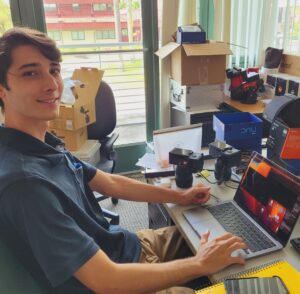
Kamea Mcmillan-Zilberman was born on Oahu spending 6 years living in Waimanalo, then moved to the mainland spending 6 years in total in L.A. and Michigan before moving back home. He graduated from Henry J. Kaiser High School in 2021 during the pandemic, and has been pursuing a degree in Electrical Engineering at Kapiolani Community College before transferring to UH Manoa next spring. He likes to read or listen to audio books, practice Taekwondo, and doodle in his spare time.
Home Island: Oahu
High School: Henry J. Kaiser High School
Institution when accepted: University of Hawaii at Manoa
Finding an Effective Cooling Method to Optimize High-Altitude Video Streaming with Consumer-Grade Electronics
Project Site: Subaru Telescope, Hilo, HI
Mentors: Michael Lemmen & Olivier Guyon
Project Abstract:
Video cameras mounted in high-altitude locations such as the ones on Maunakea are subject to harsher conditions than at sea level. Higher UV levels and prolonged exposure leads to the overheating and damage of the electronics, as well as increased noise distortion on the video itself. Researchers at Subaru Telescope are developing a camera that will be mounted on the outside railing of the Keck observatory building, allowing for high-quality images and 24-hour video streaming at high altitudes. The current camera enclosure mounted on the side of Subaru has been experiencing crashes during the day due to overheating and increases in image noise. The goal of this project is to redesign the enclosures for Subaru’s sky-monitoring cameras with cooling in mind. Due to the lower air density, these cameras require additional cooling beyond those built into the device by the manufacturer, as their effectiveness is reduced at that altitude. In 2022, a new design was made using passive cooling fans to allow airflow to pass through the camera case while preventing water from entering the enclosure. However, this new design was implemented in autumn, not summer, and was only in use for one month before lava flows cut off power to it. Using Cinema Line FX3 4K Sony cameras, this project will compare this passive cooling system with active cooling techniques to determine which has the greatest effect on improved image quality. Using the best cooling method, we will build a camera enclosure implementing either passive or active cooling. The results of this research may allow for the advancement or development of new cooling techniques used for small enclosed spaces at these altitudes, and allow for both amateur and professional astronomers to take advantage of these designs.